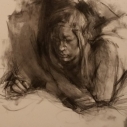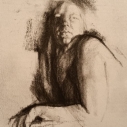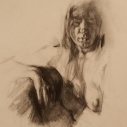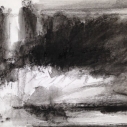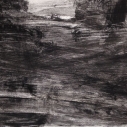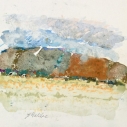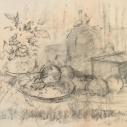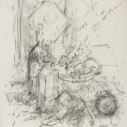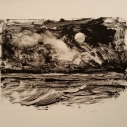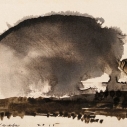October 29 – November 21, 2015
There have been a lot of conversations in recent years about “work on paper” from both an historical and contemporary perspective. Museums are acquainting their audiences with works from the masters by show casing their collections with permanent installations and public exhibitions. Previously these works were seen only by those comfortable enough to ask permission to see the work. Contemporary artists are revisiting the “crafting” of the papers, old and new. The best will use the nuances of specific papers to create some intended results while recognizing the unexpected successes as they apply ink, paint or drawing materials. They understand and respect the role it plays. At the same time both viewer and artist must be careful to not be consumed by paper for paper’s sake. It is and must always be about the work itself.
Paper was not the driving force for choosing this work, more of a realization after the fact. It began by my listening to dialogue between and amongst us. There are always conversations, daily. (I regret never having met John Heliker, but hear his voice through his work) I have the privilege of being around artists that are not only passionate about their own work, but engaged in what others are creating as well. They are constantly working. One piece leads to the next and they often bring those works to share with me and their colleagues. It is a constant flow with no ultimate end in mind. A shared sketchbook leads to chats about observation or process. Process may lead to materials. There are talks of mentors and past inspirations. But it always leads back to the work. This show is about these works. No specific connectivity. No common process or reason to be. They work beautifully together because of their honesty to themselves.
Geib’s drawings combine a mastery of materials, light, and flesh with a near obsession of developing a total understanding of the being of the subject. Sensitive sensuality combines with powerful parts and allows us to be a part of the unique complexity of his target.
Golias works from observation, not from the moment but from the experience. It is not a literal translation, but an exploitation of materials and the picture plane to create space filled with the memory of that experience. It is up to us to decide our own experience.
Shaw’s vision combines a carved intricacy with boldness, enough to feel spontaneous and non static in compositions that are complex. The picture planes are treated with depths that go beyond the restrictions I usually associate with wood block printing.
Wissler’s drawings are a poetic dance with the phrasing of color and a visual order created with strokes, existing and absent. He gives us the opportunity to see color, left on our own, we would not. The monotypes are a powerful release of movement with just enough structure to allow for an equal visual order.
If there still exists a need to justify drawings as a body of work of their own right, the drawings of John Edward Heliker (1909 – 2000) answer that call. He draws with a line that is no more and no less than what we need. Apparent effortless drawing protects us from the reality of a complicated drawing. It happens in every drawing I have seen. Incredible, again in every drawing I have seen, it seems to me that Heliker loved to draw everything around him, for the sake of drawing. A pureness and honesty that needs effort in our times to assure we continue to draw.
Work on Paper….it is about the work.
Lancaster Galleries would like to thank the Heliker-LaHoton Foundation and its Executive Director, Patricia Bailey for giving us the opportunity to include drawings by John Edward Heliker. It is an honor to exhibit work from the artist who was a mentor and inspiration to those who had the privilege of studying with him.

